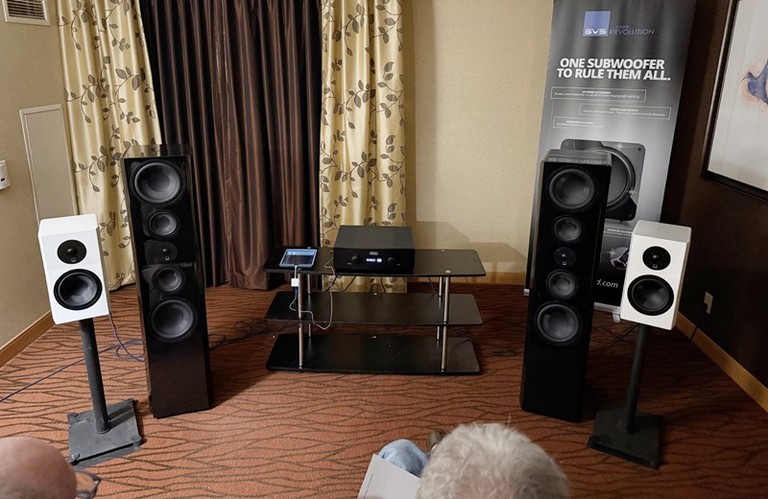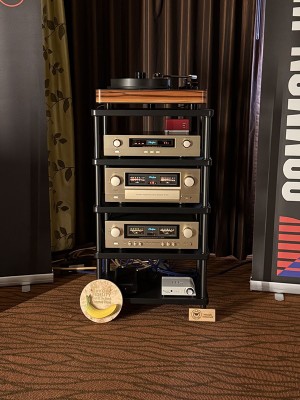T.H.E. Show SoCal 2025: More Loudspeakers Part III
SVS (2-Channel)
The concept of value is inherently subjective; it all depends on your priorities, your expectations, and your bank balance. For my money, the 2-channel SVS room represented the best value at T.H.E. Show SoCal 2025. But value aside, this minimalist system must be considered a triumph simply for the sound quality it delivered.
 The SVS team was using a Hegel H400 integrated amplifier ($7,700) to
drive a pair of SVS Ultra Evolution Pinnacle tower speakers ($5K/pair), or a pair
of Ultra Evolution Bookshelf speakers ($1,200/pair) mated with an SB-5000
R|Evolution subwoofer ($2K).
For most SVS customers, the Hegel would be considered a costly integrated, but
it turned out to be a brilliant pairing. The Hegel includes a good internal DAC
and streaming platform, and delivers a muscular 250W of Class AB power with a
high damping factor to keep the SVS towers’ quad 8-inch woofers (per speaker)
under tight control. The Ultra Evolution Pinnacle floor-standers were positioned perhaps a bit too close
together in order to accommodate the pair of Ultra Evolution Bookshelf speakers
set up along the same wall, in what might have been the ideal spots, just to
the outside of the towers.
The SVS team was using a Hegel H400 integrated amplifier ($7,700) to
drive a pair of SVS Ultra Evolution Pinnacle tower speakers ($5K/pair), or a pair
of Ultra Evolution Bookshelf speakers ($1,200/pair) mated with an SB-5000
R|Evolution subwoofer ($2K).
For most SVS customers, the Hegel would be considered a costly integrated, but
it turned out to be a brilliant pairing. The Hegel includes a good internal DAC
and streaming platform, and delivers a muscular 250W of Class AB power with a
high damping factor to keep the SVS towers’ quad 8-inch woofers (per speaker)
under tight control. The Ultra Evolution Pinnacle floor-standers were positioned perhaps a bit too close
together in order to accommodate the pair of Ultra Evolution Bookshelf speakers
set up along the same wall, in what might have been the ideal spots, just to
the outside of the towers.
Listening began with the Ultra Evolution Pinnacle floorstanders, which sounded big and clear on Angelina Jordan’s cover of “Bohemian Rhapsody.” Wanting to hear a familiar recording, I requested Sarah Jarosz’s take on the Dylan tune “Ring Them Bells.” The new diamond-coated aluminum dome tweeters from SVS resolved a great deal of detail on the plucked strings, and vocal harmonies were well sorted, achieving a natural-sounding blend while maintaining enough separation for me to track the individual melodic lines with ease. Pianist Dave Grusin has a great version of Gershwin’s “Fascinating Rhythm,” which really showed off the bass capabilities of these sizable floorstanders. The low end was remarkably agile with no sense of sluggishness or overhang on this fast-moving piece of music. These speakers make a good argument that using four 8-inch drivers has some real benefits — you get the speed of smaller drivers but the extension and power that only come with a healthy amount of cone area. To get an equivalent amount of cone area from a single woofer would require a driver over 15 inches in diameter.
Speaking of 15-inch woofers, that’s exactly what the SVS SB-5000 subwoofer is packing. And as much as I enjoyed the sound of the Ultra Evolution Pinnacle floorstanders, it was actually the 2.1-channel system combining the SB-5000 with the Ultra Evolution Bookshelf speakers that really knocked me out. “Babylon Sisters” by Steely Dan was presented on a massively wide soundstage, owing in part to the speakers’ wider positioning in the room. Despite a wealth of detail in the treble, I was relieved to find throughout the demo that SVS’s diamond tweeters don’t appear to hype-up the high frequencies the way some other designs do (no, this tweeter doesn’t sound like a Bowers & Wilkins copycat). We listened both with and without the subwoofer, which was dialed in so skillfully that it never drew attention to itself. But when the sub was on, the kick-drums and synths were given a foundational boost, making the Bookshelf speakers sound larger and more powerful without altering the overall tonal balance, which was spot-on. We listened to “The Sound of Silence” by the bass singer Geoff Castellucci, whose resonant growl was rendered with more clarity and texture than in the Hsu Research room, where an excellent subwoofer was paired with speakers and electronics that were much less expensive and (unsurprisingly) much less capable than what SVS had on offer. Compared to most gear at the show, however, the SVS system was downright affordable. Despite the relatively low prices, SVS didn’t have to make any apologies for the sound quality in this room, which was unambiguously excellent.
Chesky Audio
 Chesky
Audio is helmed by an unlikely CEO and lead designer, the 17-year-old Lucca Chesky. The son of David Chesky, Lucca comes
by his audio obsession honestly, and appears more comfortable with public
speaking than I’ll ever be. In 2024, a summer internship gave Chesky the
opportunity to conduct research at the Princeton University 3D Audio and
Applied Acoustics Lab, under Professor Edgar Choueiri (the creator of BACCH 3D Sound technology). The result is
Chesky’s first loudspeaker, the tiny LC1 Bookshelf Monitor ($996/pair). At
T.H.E. Show SoCal, Chesky was powering these interesting speakers with
electronics from California’s Wells Audio, including the Gruve DAC (starting at
$800), the Commander II
preamp (starting at $4,000) and the 150W Akasha II stereo power amp (starting
at $5,500). Chesky played music from a laptop, and cabling was from Cardas.
Chesky
Audio is helmed by an unlikely CEO and lead designer, the 17-year-old Lucca Chesky. The son of David Chesky, Lucca comes
by his audio obsession honestly, and appears more comfortable with public
speaking than I’ll ever be. In 2024, a summer internship gave Chesky the
opportunity to conduct research at the Princeton University 3D Audio and
Applied Acoustics Lab, under Professor Edgar Choueiri (the creator of BACCH 3D Sound technology). The result is
Chesky’s first loudspeaker, the tiny LC1 Bookshelf Monitor ($996/pair). At
T.H.E. Show SoCal, Chesky was powering these interesting speakers with
electronics from California’s Wells Audio, including the Gruve DAC (starting at
$800), the Commander II
preamp (starting at $4,000) and the 150W Akasha II stereo power amp (starting
at $5,500). Chesky played music from a laptop, and cabling was from Cardas.
On Billie Eilish’s “L’Amour de Ma Vie,” the bass coming from these tiny speakers beggared belief. Each speaker uses a 1 ⅛-inch silk dome tweeter (surrounded by Chesky’s unique “tessellation diffraction control technology”) and a 6.5-inch mid-woofer with a polypropylene cone. The extended bass is provided by dual inertially balanced 8-inch aluminum passive radiators — one on each of the speaker’s side panels. Chesky says that the side-firing passive radiators contribute to a wider soundstage, which was evident on NOGA’s cover of Bobby Hebb’s “Sunny.” The speakers didn’t offer the last word in resolution, but the singer’s vocal tonality and the sense of space provided by the recording (and/or reverb) were both nicely rendered. There was no noticeable cabinet coloration.
The secret sauce that enables both the aforementioned tessellation diffraction control and the silence of the cabinet is the fact that the whole cabinet is a single, solid, 3D-printed piece, making it very structurally inert. The fit n’ finish suffers somewhat from this manufacturing technique, but Chesky says it allows for complex shapes to be achieved inside the cabinet. Its internal geometry has no parallel walls and no 90-degree corners, despite the boxy appearance of the speaker’s exterior. Jacob Collier’s cover of the Beach Boys’ classic “In My Room” sounded huge, with powerful bass. The guy sitting in front of me literally asked, “Where’s the subwoofer?”. Chesky ended the demo with a popular audio-show selection, “No Sanctuary Here” by Chris Jones. Vocal clarity was good, and the fullness of the frequency range was, again, remarkable for such a small speaker. Chesky said that the speaker doesn’t measure textbook-flat, and that it was voiced by ear to deliver an immersive “you are there” sound. My takeaway was that this impressive speaker was kind of the antithesis of the Evolution Acoustics MODEL ONE — the other small speaker I heard at the show being driven by Wells Acoustics electronics. While the Evolution Acoustics speaker had a highly-resolving, refined-sounding top end, it had minimal dynamics and no low bass. The Chesky Audio LC1 Bookshelf Monitor seemed to offer a more smoothed-over top end, but it definitely delivered strong, deep, and room-filling bass.
DeVore Fidelity, Accuphase, and Dr. Feickert
The L.A.-based retailer Common Wave HiFi had at least half a dozen rooms at the show, and while I tried to visit them all, some were brimming with such jovial conversation that listening was all but impossible. I did have a chance to do some listening in the room housing DeVore Fidelity and Accuphase, and I’m glad I did. This system included the DeVore Fidelity 0/93 loudspeakers ($8,950/pair and up, depending on finish), being driven by the Accuphase E-3000 integrated amp ($8,950) or the E-700 Class A integrated amp ($16,975). An Accuphase C-57 phono stage ($13,975) received analog tunes from a Dr. Feickert Blackbird turntable with a Thomas Schick 12-inch tonearm and linear PSU ($12,190). An IsoTek V5 Aquarius power conditioner ($5K) rounded out the system, which also included Luna Cables wiring and Acoustic Sciences Corporation (ASC) room treatments.
On a track called “More” by the Swiss jazz trumpeter Erik Truffaz, this system reproduced Truffaz’s instrument with great transient bite. The electric bass energized the room with ease, as if a sub were doing the hard work (there was no sub). At least down to 40Hz, no sub was needed. Yes, there was a bit of surface noise from the vinyl, but there was also tons of detail in the snap of the percussion instruments, and a classically analog sense of flow to the sound. And, I have to say, the glowing Accuphase meters really contributed to the chilled-out energy in the room, which was being presented by John DeVore himself. The book-matched wood veneers on DeVore’s impeccably-built speakers may not have contributed to the sound, but they sure didn’t hurt either.
Stay tuned for more coverage of T.H.E. Show SoCal 2025!






